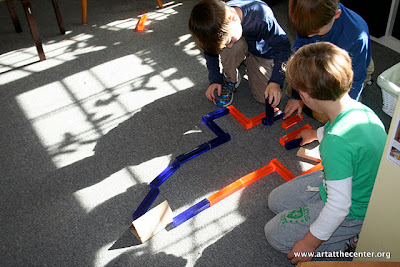The studio offers young artists many opportunities for nurturing an artistic community. It is interesting to see the influence that certain qualities of one media have on an artist’s use of another.
One such artist observed another sewing with felt, a needle, and thread and was motivated to produce clay pieces that, when fired and glazed, could then be embellished with sewing.
Small holes were poked through the bottom of a pinch pot as well as a clay slab. Working independently, the artists maintain a sense of community by learning and gaining inspiration from one another.
This community of young artists is valuable in children’s social learning within the art world as well as society. This group has shown an increasing interest in sharing artwork. Artist trading cards are the prefect vehicles for exchanging art work. They offer young artists a chance to learn from social interactions and gain a better understanding of the art world and the greater society.














